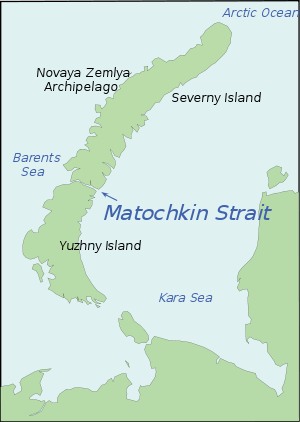
Matochkin Strait
Encyclopedia

Strait
A strait or straits is a narrow, typically navigable channel of water that connects two larger, navigable bodies of water. It most commonly refers to a channel of water that lies between two land masses, but it may also refer to a navigable channel through a body of water that is otherwise not...
between the Severny
Severny Island
Severny Island is the northern island of the Novaya Zemlya archipelago, lying north of Russia. It has an area of , making it one of the largest islands in the world. It is separated from Yuzhny Island by the narrow Matochkin Strait...
and Yuzhny Island
Yuzhny Island
Yuzhny is the southern island of the Novaya Zemlya archipelago, lying north of Russia. It has an area of , which while smaller than the northern island of Severny, makes it one of the largest islands in the world.-Ecology:...
s of Novaya Zemlya
Novaya Zemlya
Novaya Zemlya , also known in Dutch as Nova Zembla and in Norwegian as , is an archipelago in the Arctic Ocean in the north of Russia and the extreme northeast of Europe, the easternmost point of Europe lying at Cape Flissingsky on the northern island...
. It connects the Barents Sea
Barents Sea
The Barents Sea is a marginal sea of the Arctic Ocean, located north of Norway and Russia. Known in the Middle Ages as the Murman Sea, the sea takes its current name from the Dutch navigator Willem Barents...
and the Kara Sea
Kara Sea
The Kara Sea is part of the Arctic Ocean north of Siberia. It is separated from the Barents Sea to the west by the Kara Strait and Novaya Zemlya, and the Laptev Sea to the east by the Severnaya Zemlya....
. The banks along the strait are high and steep. Its length is approximately 100 kilometres (62.1 mi) and its width in its narrowest part is approximately 600 metres (656.2 yd). The strait is covered with ice for the most of the year. There are fishing settlements along the strait (Matochkin Shar, Stolbovoy).
It is also the site where, from 1963 to 1990, about 39 underground nuclear tests took place in a vast array of tunnels and shafts. After 2000, Russia started to reactivate the test site by enlarging old tunnels and starting construction work. Each summer since then various subcritical hydronuclear experiments have taken place. In 2004, Rosatom reportedly performed a series of subcritical hydronuclear experiments with up to 100 grams (3.5 oz) of weapon-grade plutonium each.

